Horace Silver was born Horace Ward Martin Tavares Silva on September 2, 1928, in Norwalk Connecticut. Shortly afterwards, his father changed the family last name to Silver. As a child, his father taught him the folk music of his native Cape Verde and his mother sang in a local church choir. In his recordings these can be heard, along with Gospel, African and Latin-American rhythms. Originally, he played Tenor Saxophone (influenced by Lester Young), but then switched to piano (influenced by Bud Powell). Silver’s big break came in 1950, while performing at the Sunset Club in Hartford Connecticut, backing up saxophonist Stan Getz, who liked the sound of Silver’s band so much that he took them on the road with him. It was with Getz that Silver made his recording debut, on the album The Stan Getz Quartet.
1. “Penny” (1951)
https://www.youtube.com/watch?v=hlGqBooKj5Y Later in 1951, Silver moved to New York City. On Monday nights, he would perform at the famous Birdland jazz club, where various musicians would arrive and informally jam together. During that year, while working as a sideman there, he met several executives from the Blue Note label and eventually signed with them, an association that lasted for nearly thirty years. Shortly afterwards, Silver co-founded Art Blakey’s Jazz Messengers, where he remained for four years.
2. “Quicksilver” (1954)
https://www.youtube.com/watch?v=s2XceklFxxc In 1956, Silver departed the band, taking with him several of the Messenger’s other musicians and forming The Horace Silver Quintet During this time, he was a pioneer in creating the aggressive style of jazz known as “Hard Bop,” involving hard-pounding rhythms that could change into sweet melodies in just a few bars.
3. “Song for my Father” (1964)
https://www.youtube.com/watch?v=CWeXOm49kE0 In 1964, he had a major hit in the highly popular album Song for my Father particularly the title track of the same name, which combined his father’s Cape Verdean folk music with hints of Brazilian Carnival in an f-minor composition. Steely Dan placed Silver into the Top 40 in the early 1970s by composing their hit single, “Rikki Don’t Lose That Number,” from the bass riff that opens the song.
4. “Self Portrait No. 1” (1979)
https://www.youtube.com/watch?v=LOzOAdl2-lM Silver commented on the social and cultural upheavals of the late 1960s and early 1970s by releasing a trio of albums collectively called, “The United States of Mind” (1970-1972). The composer got deeper into cosmic philosophy as his group, Silver ‘N Strings, recorded “Silver ‘N Strings Play The Music of the Spheres” (1979).
5. “Satisfaction Guaranteed” (1998)
https://www.youtube.com/watch?v=TOr1Q0aAFZE Silver finally ended his 30 year long association with Blue Note, recording multiple albums on the Silveto/Emerald, Columbia, Verve and Inpulse! Labels and continued to perform right through to 1998, with his final recording, “Jazz Has a Sense of Humor.” Now retired and surrounded by his close family in California, Silver received much of the recognition due a venerable jazz icon. In 2005, the National Academy of Recording Arts and Sciences (NARAS) gave him its President’s Merit Award. Silver passed away on June 18 of this year. He was 85.
“Music is my life and I hope to be able to do it all my life, until the very last moment when my spirit leaves my body. I’m so happy that I was blessed with the gift of music. It has seen me through my life. When everything else gets down, when I get the blues, I always think ‘well, I’ve got music.’ I may have lost this and lost that, but I’ve still got music. Lady music has not left me. She’s always my sweetheart,” he laughs. “She ain’t never gonna leave me, because she loves me and I love her. This is forever. What’s the song? “This Isn’t Sometimes, This is Always.” — Horace Silver









Join the conversation as a VIP Member